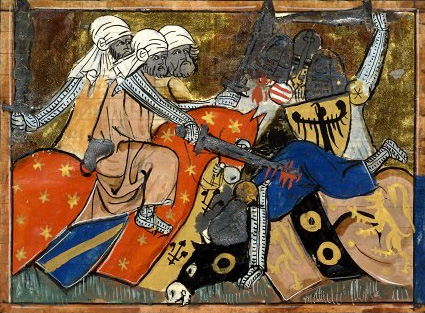The Crusades (Part 1)
St. Francis of Assisi
Francis lived in an age when Crusades to free the Holy Land were part of Christian life. Did you know Francis was part of the 5th Crusade? But do you know his role?

One of the events of Francis’ life that has received scant public attention was his meeting with the sultan of Egypt, Al-Malik al-Kamil in 1219 during the so-called “Fifth Crusade.” This meeting has loomed large in the imagination of the “Franciscan world” because of its effect on the Rule of Life and in the Franciscan charism of missions, but has only recently gained public attention because of the new era of tensions with the Islamic world. People are surprised to learn that Francis was part of a crusade – a claim that scholars argue to no end as they argue so many other aspects of Francis’ life. Each side has generally already taken a view of the little poor man from Assisi: Francis the loyal churchman or Francis the radical reformer. Those views are often revelatory of how the scholar views the Crusades. And as with all things, history has a context.
The religion and political power of Islam emerged from the Arabian peninsula in the mid-seventh century, reaching India and Spain within 100 years. During those 100 years, more than half of what were formerly “Christian lands” were swallowed up under the banner of military jihad. The Christian communities of Palestine, Syria, Asia Minor, Egypt, and North Africa were greatly reduced and in some cases disappeared. In the year 711, Muslim armies invaded the Spanish mainland, occupying and controlling major portions of Spain until 1492. By the end of the eleventh century, the Byzantine Empire had lost most of modern Turkey to the Muslim armies. With the capital, Constantinople, now under military pressure, Emperor Alexius I appealed to Pope Urban II for armed forces to help stave off the Muslim advances. Thus the medieval crusading era was inaugurated. The traditional values associated with pilgrimage and martyrdom were combined with chivalry in what was cast as a defense of the faith.
How did all this possibly impact Francis? Given Francis’ own experience as a would-be knight in the Battle of Colestrada in 1202 which resulted in his year-long experience as a prisoner of war and subsequent years of possibly dealing with symptoms very similar to PTSD – one would rightly question what Francis would be doing anywhere near a crusade. But Colestrada was not the only influence in his life. Francis– even in the period when the Franciscan order was beginning to take shape – always showed signs of his continued formation in the age when pilgrimage, martyrdom, and chivalry were values of society.
As the West began to emerge from the “dark ages,” an unusual monastic spirituality emerged in the West that was suited for the task of evangelizing peoples: pilgrimage. What began among the Irish monks as a penitential practice, i.e., ascetic homelessness, became a form of pilgrimage signifying renunciation. The monks were peregrination pro Christo (“wandering for the sake of Christ”). If one has been reading these articles, this peregrination should strike you as a perfect example of the early friars wandering around Italy, France, Spain, and the Germanic areas. In other words, pilgrimage in this form was already in the marrow of the Franciscans.
The ideal of seeking martyrdom as a gradual drawing near to Christ crucified was connected to the ideal of pilgrimage. Western monasticism had already articulated a theology of “progressive martyrdom” along a spectrum from asceticism to the acceptance of death as a consequence of preaching the Gospel. This ideal had so impregnated Western Christianity that even the late–Middle Ages heretics retained the understanding.
The Christian heritage of Assisi is suffused with the story of martyrs, as attested by the large number of chapels and churches constructed over their tombs and celebrations on liturgical calendars. The legenda of martyrs in and around Assisi begin with St. Feliciano, bishop of Foligno, who evangelized in the Assisi area and was killed in the year 250 CE. The first bishop of Assisi, San Rufino, was a martyr (d. 238), as was his successor, St. Vittorino (d. ca. 250), as well as the third bishop, St. Savino.
The eleventh-century revival of the cult of St. Rufino shaped the ecclesial and communal landscape of Assisi. The fervor of the age resulted in the construction of a large church that became the focus of civic pride and identity. By the thirteenth century the devotion to the Assisi Martyrs was public and prominent. The celebrations recalled the courage, devotion, perseverance, and fidelity of the saints. Some scholars hold that Francis was the leader of the celebration that reenacted the martyrdom of St. Vittorino.
While martyrdom had often been the stuff of ecclesial legend, the cult of the local martyrs’ fervor and heroism was widely circulated in Assisi and came to form part of the fabric of life of the context in which young Francis grew to maturity. His particular attention to the local cults is mentioned by Francis’ biographers as well as forming the content of the Sixth Admonition: “Therefore, it is a great shame for us, the servants of God, that the saints have accomplished great things and we want only to receive glory and honor by recounting them.” It will not be surprising to see martyrdom emerge as a recurring theme in the life of Francis.